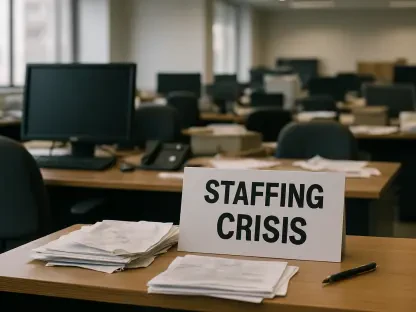The corporate landscape in 2025 stands at a critical crossroads, grappling with a striking 30% surge in lawsuits alleging reverse discrimination over the past two years, as reported by industry watchdogs. This wave of legal challenges raises profound questions about the sustainability of Diversity, Equity, and Inclusion (DEI) initiatives, once heralded as cornerstones of modern workplace culture. Companies across sectors are reevaluating their policies amid growing scrutiny, navigating a tightrope between fostering inclusivity and avoiding claims of bias against majority groups. This report delves into the evolving dynamics of reverse discrimination, its legal implications, and the broader impact on DEI strategies, offering a comprehensive look at an issue reshaping corporate America.
Understanding Reverse Discrimination and DEI Dynamics
Reverse discrimination, a term describing perceived bias against historically dominant groups due to affirmative action or DEI policies, has emerged as a contentious issue in today’s workplaces. Often tied to hiring, promotions, or training programs, these claims suggest that efforts to level the playing field for underrepresented groups may inadvertently disadvantage others, particularly White employees or men. The concept has gained traction as more individuals and legal entities question the fairness of certain corporate practices.
DEI initiatives, designed to promote diversity, ensure equitable opportunities, and foster inclusive environments, have become integral to organizational missions over recent decades. Adopted by a vast majority of Fortune 500 companies, these programs aim to address systemic inequalities, enhance employee engagement, and reflect broader societal values. Their widespread implementation underscores a commitment to creating workplaces that mirror diverse customer bases and communities.
Yet, tension brews beneath the surface as DEI policies face criticism for potentially alienating majority groups. Legal challenges alleging reverse discrimination highlight a growing divide, with some arguing that these initiatives prioritize quotas or optics over merit. This friction sets the stage for a deeper examination of how companies can balance inclusivity goals with perceptions of fairness across all demographics.
Legal Landscape of Reverse Discrimination Lawsuits
Key Case Studies and Outcomes
A notable case involving Warner Bros. exemplifies the complexities of reverse discrimination claims in 2025. A White camera operator alleged racial bias and retaliation in hiring practices linked to the company’s DEI commitments, but the 9th U.S. Circuit Court of Appeals ruled against the plaintiff on October 27, affirming a lower court’s decision. The judiciary emphasized the absence of concrete evidence showing race as a factor in hiring, underscoring that decisions were based on legitimate, non-discriminatory criteria.
Other cases reflect similar judicial skepticism, such as a dismissed lawsuit by a White professor against Penn State Abington and another by a White male former employee against 3M, both failing to prove discriminatory intent. However, not all outcomes favor defendants; Texas A&M University-Texarkana settled a race bias claim with a White former worker for $1 million, signaling that some organizations may prefer resolution over prolonged litigation. These settlements hint at strategic moves to mitigate reputational risks or escalating legal costs.
The varying results of these cases illustrate a critical judicial principle: evidence over speculation. Courts consistently demand tangible proof of bias directly tied to DEI policies rather than broad assumptions about their impact. This pattern suggests that while claims are mounting, success hinges on substantiating specific discriminatory actions rather than systemic critiques.
Trends in Legal Challenges and Success Rates
The uptick in reverse discrimination lawsuits marks a significant shift, with filings increasing steadily since 2025, reflecting heightened awareness and willingness to challenge DEI frameworks. Outcomes remain mixed, with many cases dismissed for lack of evidence, yet a small fraction achieving settlements or favorable rulings. This inconsistency points to a legal landscape still grappling with how to interpret fairness in the context of equity-driven policies.
Judicial focus remains on establishing discriminatory intent, a high bar that plaintiffs often struggle to meet. Decisions frequently hinge on whether DEI policies explicitly influenced adverse employment actions, rather than merely existing as corporate goals. This stringent requirement shapes how cases are argued and defended, pushing both sides to prioritize hard data over anecdotal grievances.
These legal trends mirror broader societal shifts, where skepticism toward DEI programs grows amid cultural debates over meritocracy and privilege. As public opinion fractures, courts serve as battlegrounds for competing visions of workplace equity, with outcomes influencing how companies craft and communicate their inclusion strategies. The evolving dialogue suggests that legal challenges will continue to test the boundaries of acceptable DEI practices.
Challenges Facing DEI Initiatives Amid Legal Scrutiny
DEI programs confront mounting obstacles as lawsuits proliferate and cultural pushback intensifies in 2025. Organizations face criticism from multiple fronts, with some stakeholders viewing these initiatives as divisive or unfairly targeted. This environment creates uncertainty, prompting many firms to scale back ambitious diversity goals or reframe their public messaging to avoid potential litigation.
Human resources professionals and corporate leaders exhibit growing caution, influenced by guidance from bodies like the U.S. Equal Employment Opportunity Commission, which has flagged certain DEI activities as potentially unlawful. The fear of legal repercussions permeates decision-making, with some companies hesitating to implement robust training or hiring targets. This hesitancy risks stalling progress on inclusion while amplifying perceptions of inequity among employees.
To navigate these challenges, firms are exploring strategies like policy reevaluation and enhanced transparency in decision-making. Revising DEI frameworks to emphasize merit alongside diversity, coupled with clear documentation of employment actions, offers a pathway to balance goals with compliance. Such measures aim to rebuild trust across workforces while safeguarding against claims of bias, though their effectiveness remains under scrutiny.
Regulatory and Compliance Considerations for DEI Policies
Federal regulations play a pivotal role in shaping how DEI practices are designed and implemented, with agencies issuing warnings about the legal risks of overzealous initiatives. Guidelines stress that policies must avoid creating preferential treatment based on protected characteristics, a directive that compels organizations to scrutinize their approaches. Non-compliance can lead to significant penalties, amplifying the stakes for corporate adherence.
Compliance in hiring and workplace policies emerges as a critical shield against litigation, requiring meticulous attention to fairness in processes. Companies are urged to ensure that DEI efforts align with anti-discrimination laws, documenting rationales for decisions to demonstrate impartiality. This focus on procedural integrity helps mitigate risks while maintaining commitment to equity objectives.
Regulatory scrutiny continues to influence corporate behavior, pushing firms toward evidence-based implementation of DEI strategies. The emphasis on measurable outcomes and justifiable actions reshapes how inclusion is prioritized, with many organizations adopting cautious, data-driven frameworks. Balancing regulatory demands with aspirational goals remains a delicate task, central to sustaining credible DEI efforts.
The Future of DEI in Light of Reverse Discrimination Claims
Looking ahead, DEI initiatives face an uncertain trajectory as legal and societal pressures mount in 2025 and beyond. Persistent lawsuits may compel a reimagining of these programs, with potential shifts toward more neutral language or redefined metrics of success. The coming years, particularly through 2027, could see a recalibration of how equity is pursued amid evolving expectations.
Innovations in policy design offer hope for addressing fairness concerns without abandoning inclusion aims. Concepts like skills-based hiring, blind recruitment processes, and universal development programs are gaining traction as ways to minimize bias perceptions. These adaptations seek to create environments where opportunity is accessible to all, potentially reducing the grounds for reverse discrimination claims.
Cultural debates, political polarization, and economic conditions will undoubtedly shape the evolution of workplace inclusion. As public discourse sways between advocacy for equity and calls for colorblind policies, companies must navigate a polarized landscape. Economic downturns or shifts in labor markets could further complicate DEI priorities, testing the resilience of corporate commitments in turbulent times.
Conclusion: Navigating the DEI and Reverse Discrimination Debate
Reflecting on the discourse, the intersection of reverse discrimination lawsuits and DEI programs reveals a complex struggle for balance within corporate spheres. The legal battles, marked by a demand for concrete evidence, underscore the fragility of policies under scrutiny, while cultural divides amplify the stakes for organizations. Each case and regulatory warning serves as a reminder of the tightrope companies walk in pursuing equity.
Moving forward, actionable steps emerge as vital for progress. Firms are encouraged to adopt transparent frameworks, ensuring decisions are backed by data and communicated clearly to all stakeholders. Prioritizing universal access to opportunities, rather than group-specific targets, offers a potential solution to mitigate legal risks. These strategies aim to rebuild trust across diverse workforces.
Ultimately, the path ahead demands a nuanced approach, blending compliance with genuine inclusion efforts. Continuous dialogue with legal experts and employees alike is seen as essential to refine DEI practices. By embracing adaptability, organizations position themselves to navigate future challenges, fostering workplaces that value fairness for every individual.









